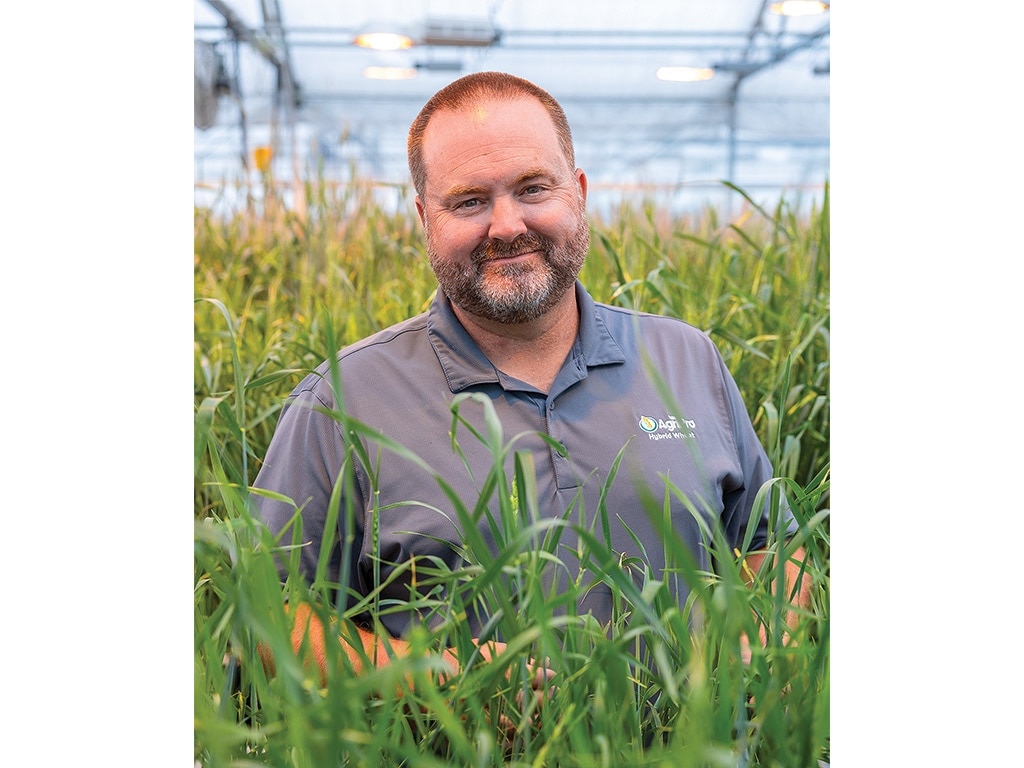Agriculture, Education November 01, 2023
Hybrid Wheat Takes Root
.
Farmers set to capitalize on yield stability.
Spring wheat is an important component of Dave Hankey's crop rotation.
On his farm near Park River, North Dakota, wheat bridges the gap between corn and sugar beets, providing a wealth of agronomic benefits, including an ideal seedbed for the small-seeded sugar beets; plus weed and pest control attributes from crop rotation.
Despite its fit in a long-term cropping system, wheat still needs to pay its way. Hankey notes that sugar beets and corn—his other cash crops—have made dramatic gains in yield and profit potential. Wheat? Not so much.
That's why new hybrid wheat lines show such promise.
After 13 years of research and testing, AgriPro® is launching hybrid wheat lines. Spring wheat growers in the northern plains get the first opportunity to grow these wheats, which should stabilize yield and offer yield increases in ideal growing conditions, says Jon Rich, hybrid wheat operations lead at Syngenta, the parent company of AgriPro.
Hybrid lines should result in a 10-12% yield increase over varietal wheat, plus additional advantages, including yield consistency from year to year, disease and insect resistance, and quality improvement.
"The first rollout will be to farmers that are looking for higher end yields, who want to push management on their farm," Rich says. "We're still learning on which acres these hybrids fit best and place them where they will be most successful."
Syngenta isn't the first company to invest in hybrid wheat. Commercial efforts in the 1990s ended due to the logistical challenges of hybrid development and delivery. Plus, the added cost of hybrids to farmers was difficult to overcome.
In the late 2000s, Syngenta, BASF, Bayer Crop Science, Corteva Agriscience and Limagrain Cereal Seeds intended to bring hybrid wheat lines to market. In 2018, Bayer transferred its hybrid research to BASF, which announced earlier this year it was abandoning its North American wheat research. Meanwhile, Texas A&M and the University of Nebraska are working on a joint public hybrid breeding program.
Developing wheat hybrids is complex. A wheat plant has three whole genomes in each cell, and often six copies of each gene. Wheat breeders must remove the natural ability of wheat plants to pollinate themselves, then pair male and female parents to produce desired traits (yield, quality, stalk strength, etc.).
Farmers can expect to pay more per unit of seed and plan to buy new seed every year, Rich says. That investment back into hybrids will help the company develop better hybrid wheats, the wheat breeder adds, perpetuating improvement of the technology.
Above. For 13 years, Jon Rich, AgriPro's hybrid wheat operation’s lead, has worked to commercialize hybrid wheat. Spring wheat growers have tested hybrid lines for two years, showing yield stability and other agronomic benefits.
Can hybrids help? Acres planted to all classes of wheat by U.S. farmers peaked in 1982 at 88.25 million acres, according to the U.S. Department of Agriculture. Only 46.7 million acres were planted in 2021. (There are six classes of wheat: Hard Red Winter; Hard Red Spring, Soft Red Winter, Soft White, Hard White, and Durum.) Meanwhile, yields of other crops have trended higher at a faster pace, due in part to investment in variety and hybrid research.
"Wheat has always lagged behind those other crops in research and development investment, and in profitability," Rich says. "That's why we want to introduce this new technology the right way."
AgriPro plans to make spring wheat hybrids available for a full launch in the Northern Plains in 2025.
The company plans to have a limited supply of Hard Red Winter hybrids in 2025, aiming for full commercial launch of two hybrids in 2026.
Hankey, meanwhile, says the hybrid wheat lines tiller better than varietal wheat and feature large, grain-filled heads. They have been Hankey's best-yielding wheat two years running.
"This is the first technology in wheat to come along in quite some time that gives us hope," Hankey says. "It could be a game changer for us." ‡
Read More

AGRICULTURE, SPECIALTY / NICHE
Do You Know Where Tequila Comes From?
Spoiler: The distilled sugar does not come from agave leaves.

AGRICULTURE, SUSTAINABILITY
Greens Get a New Flow
Local Bounti stacks the greenhouse growing deck for max return.


